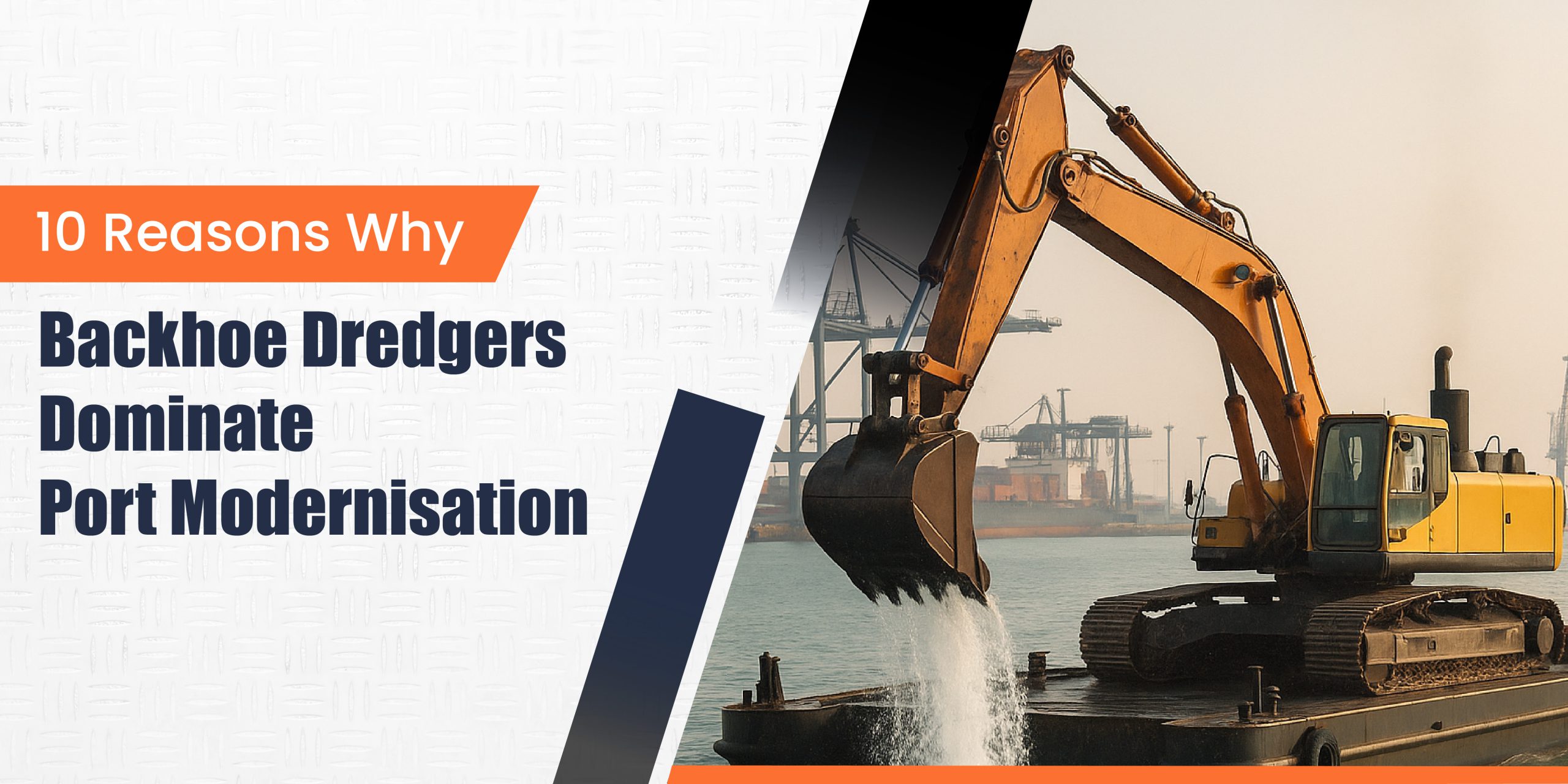Blogs

10 Reasons Why Backhoe Dredgers Dominate Port Modernization
As global trade escalates and shipping vessels grow larger, the imperative to modernize ports intensifies. Ports are the arteries of international commerce, and their efficiency directly impacts national economies. In this vital endeavor, one piece of marine heavy machinery consistently stands out: the Backhoe Dredger. Renowned for its unique blend of power and precision, the backhoe dredger has become the preferred choice for port authorities and contractors worldwide, particularly for capital dredging projects that reshape the very foundations of marine infrastructure.
At Rock And Reef, with over 25 years of experience in capital dredging and marine infrastructure development in India, we’ve witnessed firsthand the indispensable role backhoe dredgers play in transforming visions of modern ports into reality. Here are 10 compelling reasons why these robust machines dominate port modernization:
1. Unmatched Precision in Complex Environments
Port modernization often involves intricate work near existing structures, jetties, pipelines, and confined berths. Backhoe dredgers excel in these challenging scenarios. Unlike other dredger types, their hydraulic arm and bucket offer surgical precision, allowing operators to target specific areas for excavation with centimeter-level accuracy. This minimizes over-dredging, reduces environmental impact, and ensures that critical infrastructure remains undisturbed, making them ideal for detailed shaping of channels and berths.
2. Versatility Across Diverse Materials
Modern ports are built on varied geological foundations. From soft silts and sands to stiff clays, compacted soils, and even blasted rock, a port modernization project can encounter a wide spectrum of materials. Backhoe dredgers are engineered to handle them all. Their immense digging force and specialized buckets can efficiently excavate everything from unconsolidated sediments to heavy, cohesive materials and debris, offering unparalleled adaptability to site-specific conditions.
3. Deep Digging Capabilities for Mega Vessels
The age of mega container ships demands deeper navigational channels and berths. Backhoe dredgers, especially the larger variants, can reach impressive dredging depths—up to 35 meters or more. This capability is critical for deepening existing waterways and creating new ones, enabling larger vessels to access ports safely and efficiently, thereby boosting a port’s capacity and global competitiveness.
4. Efficient Handling of Hard and Blasted Rock
One of the most formidable challenges in port development is encountering rock formations. While some dredgers struggle, backhoe dredgers, often referred to as “precision powerhouses” for this very reason, are undisputed champions at excavating hard rock, compacted soils, and blasted rock. Their powerful hydraulic systems and heavy-duty buckets allow them to break through and remove materials that would halt other dredging equipment, ensuring project continuity even in the toughest geological conditions.
5. Minimal Interference with Port Operations
Port modernization projects often occur in active shipping lanes. Backhoe dredgers, typically moored by spud poles, maintain a stationary position without the need for extensive anchor wire layouts that could interfere with passing vessel traffic. This localized footprint and self-contained operation reduce disruptions to ongoing port activities, allowing for simultaneous dredging and shipping, a significant advantage for busy ports.
6. Integration of Advanced Technologies for Optimal Performance
The efficiency of backhoe dredgers has been significantly enhanced by technological advancements. Modern units are equipped with real-time kinematic (RTK) GPS systems for precise positioning and tracking of the bucket’s exact underwater location. Coupled with sophisticated 3D dredging software, operators can visualize the seabed, plan intricate digging paths, and monitor progress against design profiles in real-time, ensuring maximum accuracy, reduced rework, and optimized operational efficiency.
7. Ideal for Confined Spaces and Nearshore Work
Port infrastructure often includes quay walls, docks, and other structures that create confined dredging areas. The compact footprint and articulated arm of a backhoe dredger allow it to operate effectively in tight spaces where larger or less maneuverable dredgers cannot. This makes them perfectly suited for maintenance dredging along berths, clearing dock basins, and executing trenching works for pipelines or cables near existing facilities.
8. Robustness and Reliability in Demanding Conditions
Port modernization is a demanding task, often requiring continuous operation in harsh marine environments. Backhoe dredgers are built to withstand these conditions. Their robust construction, powerful hydraulic systems, and durable components ensure high reliability and minimal downtime, crucial for meeting tight project deadlines and maintaining consistent progress on large-scale infrastructure initiatives.
9. Contributing to Environmental Stewardship
While dredging inherently impacts marine environments, modern backhoe dredgers facilitate more sustainable practices. Their precision excavation capabilities minimize over-dredging, reducing the overall volume of material that needs to be treated or disposed of. Furthermore, the ability to selectively remove contaminated sediments contributes to environmental remediation efforts, aligning with the growing emphasis on responsible and eco-friendly port development.
10. Cost-Effectiveness Through Efficiency and Reduced Rework
The combined benefits of precision, versatility, and advanced technology translate into significant cost-effectiveness for port modernization projects. By achieving accurate excavation the first time, minimizing material handling, and reducing the need for rework, backhoe dredgers contribute to faster project completion and lower operational expenditures. This efficiency makes them a financially sound investment for long-term port development and maintenance.
Conclusion
The dominance of backhoe dredgers in port modernization is not accidental; it’s a testament to their unparalleled capabilities in meeting the evolving demands of global trade and marine infrastructure. From their surgical precision in complex environments to their robust ability to handle diverse materials and integrate cutting-edge technology, these machines are indispensable tools for building the ports of tomorrow. For any port authority or developer embarking on modernization, understanding the distinct advantages of backhoe dredgers is the first step towards a successful, efficient, and sustainable future.

